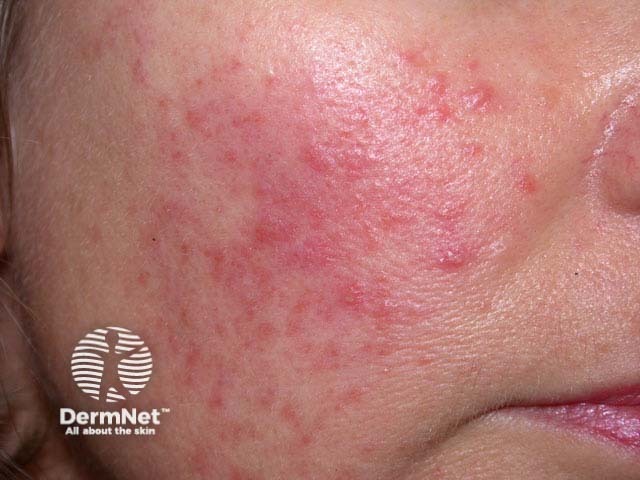Main menu
Common skin conditions

NEWS
Join DermNet PRO
Read more
Quick links
For each of the ten cases, study the image(s) and then answer the questions. You can click on the image to view a larger version if required.
Each case should take approximately 2 minutes to complete. There is a list of suggested further reading material at the end of the quiz.
When you finish the quiz, you can download a certificate.

What is the diagnosis?
Rosacea
Describe the clinical features of this disorder.
Rosacea tends to occur in middle aged women and men. A variable rash is often accompanied by varying degrees of flushing and telangiectasia. Rosacea affects the cheeks, nose, chin and forehead, and is especially prevalent in those with fair skin. It is characterized by mid-facial erythema, asymptomatic papules and superficial pustules.
Symptoms are aggravated by vascular dilatation due to sun exposure, hot and spicy food or drink or rapid change in environmental temperature. Rosacea may be accompanied by blepharitis or meibomianitis (erythematous papules on eyelid margins). Localized frim swelling may occur, most often rhinophyma.
Which laboratory tests are helpful, if any?
The diagnosis of facial rashes is nearly always made clinically. Occasionally, a skin biopsy is indicated. Follicular inflammation (sometimes granulomatous) and vascular dilatation are typical of rosacea.
What treatment would you recommend?
Tell your patients to cleanse the face twice daily with mild soap or non-soap non-cream cleanser and water. Emollients are not helpful and may aggravate rosacea. Patients often demand them however to relieve dryness and stinging; recommend they choose non-oily products including sunscreens.
Oral anti-inflammatory antibiotics such as tetracycline 250-500 mg, doxycycline 100mg daily or minocycline 100mg daily are used for 4-12 weeks for rosacea. Use erythromycin in pregnancy if treatment is essential. A longer course may be required for longstanding cases with persistent erythema, and it may need to be repeated for flare-ups.
Erythromycin, metronidazole or azelaic acid preparations may be effective for rosacea. If a topical steroid has been used, warn of a possible flare-up on stopping and if necessary continue a milder product at decreasing intervals over two or three weeks.
Patients with rosacea may be able to reduce facial flushing by avoiding extremes of temperature and minimizing exposure to hot or spicy foods and alcohol. Vascular laser treatment of telangiectasia and surgical correction of rhinophyma may be very effective.